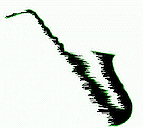Saxophone and the orchestra
During a recent thread on the John Zorn mailing list, a comment appeared about how little the saxophone is used in the symphony orchestra. As is usually the case, there is a misconception that only a handful of pieces were written using the saxophone in this context and this was once again reflected in the mentioned comment. Here was my response to that thread.
"Actually, there is a lot more orchestral music which includes the saxophone then most people are aware of. I've collated a list of over 3000 pieces, not including saxophone concertos, which is another subject. Apart from the better known work's like Ravel's Bolero, his arrangement of Mussorgsky's Pictures of an Exhibition, Bizet's L'Arlésienne, George Gershwin's Rhapsody in Blue.
Without getting too involved nor exhaustive, here is a list of some of the composers (ordered alphabetically) who have included saxophone in their orchestral works (including some operas). They range through all styles. You may recognize some of the names:
John Adams, Thomas Adès, William Albright, David Amram, Louis Andriessen, Denis Apivor, Malcolm Arnold, Bela Bartok, Pierre-Philippe Bauzin, Alban Berg (most notably in his opera Lulu); Luciano Berio, Leonard Bernstein, Williams Bolcom, Pierre Boulez, Anthony Braxton, Michel-George Brégent, Benjamin Britten, Gavin Bryars, John Cage, Cornelius Cardew, John Alden Carpenter, Elliott Carter, Friedrich Cerha, Gabriel Charpentier, David Cope, Aaron Copland, Luigi Dallapiccola, Michael Daugherty, Anthony Davis, Claude Debussy, Leo Delibes, David Del Tredici, Claude Delvincourt, David Diamond, Maurive Duruflé, Henri Dutilleux, Jindrich Feld, Michael Finnisy, Lucas Foss, Philip Glass, Vinko Globokar, Morton Gould, Bob Graettinger, Percy Grainger, Ferde Grofe, John Harbison, Roy Harris, Hans Werner Henze, Arthur Honegger, Alan Hovhaness, Karel Husa, Jacques Ibert, Vincent d'Indy, Charles Ives, André Jolivet, Piet Ketting, Aram Khatchaturian, Zoltan Kodaly, Charles Koechlin, Gyorgy Ligeti, Frank Martin, Jules Massenet, Toshiro Mayuzumi, Chiel Meijering, Giacomo Meyerbeer, Darius Milhaud, Luigi Nono, Krzysztof Penderecki, Francis Poulenc, Serge Prokofiev, Ned Rorem, Camille Saint-Saens, Esa-Pekka Salonen, Peter Schat, Arnold Schoenberg, Gunther Schuller, William Schuman, Ralph Shapey, Dimitri Shostakovitch, Karlheinz Stockhausen, Richard Strauss, Mark Allan Taggart, Toru Takemitsu, Virgil Thomson, Henri Tomasi, Michael Torke, Mark-Anthony Turnage, Ralph Vaughan Williams, Heitor Villa-Lobos, William Walton, Bernd Aloys Zimmermann.
The problem of the saxophone in the classical realm is a matter of bad historical timing. When Adolph Sax invented his instrument around 1840, one of his most devout fan was Hector Berlioz who actually wrote the first piece ever for the saxophone (a sextet named "Chant sacre" for clarinet, bass clarinet, bass sax, cornet, bugle and high trumpet; all instruments which were either invented by or improved by Sax) and wrote a chapter in his Orchestration book. Unfortunately for the saxophone's position in the orchestra, this was at the end of Berlioz's most productive writing career. Most of his important orchestral pieces (a.k.a. Symphonie fantastique) had already been written. But this did not prevent certain composers popular in France at the time to take up the cause. Folks like George Kastner, Meyerbeer, Saint-Saens, Vincent d'Indy, Massenet and Bizet included the saxophone in their operas and other pieces.
Adolphe Sax also worked hard to get the saxophone included in the military band system in France. Here's were another quark of history comes into play. The political situation in France was, to put it mildly, volatile throughout the 19th century. So depending on which political system was in force, wavering between being a Republic or an Empire, Sax's band instruments were either in or out of the official band system. He also had several rivals who plotted to usurp his definite monopoly on production of high quality wind instruments, which, at the end left him bankrupt at the end of his life.
So here we are left with the saxophone which arrived a little to late for Berlioz to truly include it in his orchestral works, whose reputation and influence has an orchestrator would have undoubtedly helped to establish a better situation for the saxophone in the late 19th century orchestra. Also arriving in the midst of political upheaval which deterred its use in the military band system which would also have contributed to it having a better life in the classical field, since a lot of composers had to go through the military system in France at one point or another in their early career.
We end up in the 20th century where, as you can see by the above mentioned list of composers, the saxophone regained some place in the orchestral realm. However this is counter balanced by the fact that the orchestral world, especially in the 20th C, is one of great conservatism (to put it mildly). Just run through the list and ask yourself, how many times have you seen these composers programmed in your local orchestras. Need I say more.
Is it any wonder that the saxophone's role of the orchestral realm is so poorly acknowledged. In fact, the saxophone suffers the same situation as most contemporary composers who try to enter the symphonic field. If more modern composers were performed, you'd most likely see more saxophone being used, and probably more orchestras hiring full time sax players.
The saxophone did live through a craze in the 1920's, especially in the US. It is said that at the time, there were more saxophones being sold then pianos, which is a feat since the was a piano in most households at the time. This is pre-radio, pre-television. A time when the piano was the center of musical life in the home. This fact probably helped it's evolving into the jazz instrument which most people relate to today."
